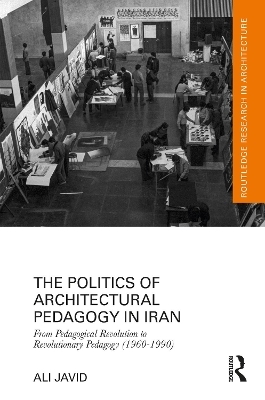
The Politics of Architectural Pedagogy in Iran
Routledge (Verlag)
978-1-032-74312-7 (ISBN)
By examining the critical role of education in achieving geopolitical objectives during the Cold War, this book explores architectural pedagogy as an agent for resistance and revolution. It highlights how architectural pedagogy not only reflects radical ideologies but also actively engages in socio-political transformation. The book uncovers how architectural pedagogy became one of the mechanisms to accomplish revolutionary goals. This is evident in initiatives like the "Pedagogical Revolution" during the White Revolution (1963), aimed at modernizing educational institutions, and the "Revolutionary Pedagogy" during the Islamic Revolution (1979), which sought to serve the masses and the religious revolutionary society. In this way, the book adds a new geopolitical perspective to the contemporary discourse of radical pedagogies.
This book explores the intricate connections between architectural pedagogy and politics through a transdisciplinary approach. It analyzes original multilingual documents, including political agendas, cultural agreements, curricula, teaching methods, student works, exhibitions, and conferences. It will be of interest to architectural historians and architecture students, particularly those interested in Global South development, modernism, architectural pedagogy, international relations, and Middle Eastern studies.
Ali Javid is a researcher in architectural history and theory based in Australia. He received his PhD in history and theory of architecture from the University of Western Australia in 2023. His primary field of research is architectural pedagogy and the history and theory of architecture.
List of Figures
Acknowledgements
Introduction
Chapter 1 The Cultural Diplomacy and the Transformation of Iranian Architectural Pedagogy
Introduction
The 1963 White Revolution, The Pedagogical Revolution and a Transitional Reform from Feudal to Modern Society
The Faculty of Architecture at the National University: An Alternative Pedagogy to the Faculty of Fine Arts at the University of Tehran
Cultural diplomacy, and the role of Foreign Cultural associations in Iranian architectural pedagogy
Conclusion
Chapter 2 Architectural Pedagogies for Development
Introduction
Architectural Pedagogy for the White Revolution’s Agenda: The Architecture Faculty of National University (1959–1968)
Faculty of Fine Arts, University of Tehran: Emerging an Alternative Pedagogy
Conclusion
Chapter 3 From Westoxification to National and Transactional Iranian Student Protest in 1968
Introduction
Iranian Expatriate Architecture Student Groups in Italy and the US
National University (1968–1974): The introduction to vernacular pedagogy
Fine Arts (1968–1974): From the End of Beaux-arts to the Introduction of Environmental Pedagogy
Conclusion
Chapter 4 Pedagogies for the Quiet Revolution
Introduction
National University (1974–1979): From Anti-Developmental Pedagogy to a Pedagogy for the 1979 Revolution
Fine Arts (1974–1979): From Vernacular Studies to Popular Studios
Conclusion
Chapter 5 Forming an Architecture Pedagogy to Serve the 1979 Revolution
Introduction
Architectural Pedagogy Seminars at Fine Arts: Revolution and Populist Pedagogy
The Journal of Society and Architecture: The Revolutionary Institution and an Alternative Architectural Pedagogy
From Cultural Pedagogy to the Cultural Revolution: Nadimi and Garmsar Studio in National University in the 1979–1980 Academic Year
Conclusion
Chapter 6 The Cultural Revolution (1980–1983) and the Emergence of Islamic Architecture Pedagogy
Introduction
Islamic structure and system for architectural pedagogy
Architectural Pedagogy after the Cultural Revolution (1984–1989)
Conclusion
Conclusion
Index
| Erscheinungsdatum | 02.08.2024 |
|---|---|
| Reihe/Serie | Routledge Research in Architecture |
| Zusatzinfo | 26 Line drawings, black and white; 54 Halftones, black and white; 80 Illustrations, black and white |
| Verlagsort | London |
| Sprache | englisch |
| Maße | 156 x 234 mm |
| Gewicht | 517 g |
| Themenwelt | Naturwissenschaften ► Biologie ► Ökologie / Naturschutz |
| Sozialwissenschaften ► Politik / Verwaltung | |
| Sozialwissenschaften ► Soziologie ► Spezielle Soziologien | |
| Technik ► Architektur | |
| ISBN-10 | 1-032-74312-3 / 1032743123 |
| ISBN-13 | 978-1-032-74312-7 / 9781032743127 |
| Zustand | Neuware |
| Informationen gemäß Produktsicherheitsverordnung (GPSR) | |
| Haben Sie eine Frage zum Produkt? |
aus dem Bereich


